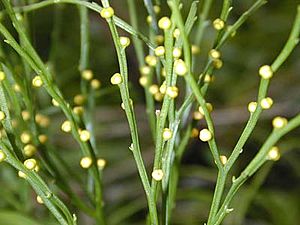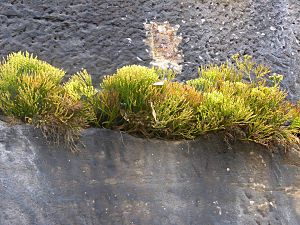Whisk fern facts for kids
Quick facts for kids Whisk fern |
|
|---|---|
 |
|
| Scientific classification | |
| Genus: |
Psilotum
|
| Species: |
nudum
|
| Synonyms | |
|
|
Psilotum nudum, also known as the whisk fern, is a unique plant that looks a lot like a fern. Unlike most plants, it doesn't have roots!
This interesting plant grows in many warm parts of the world. You can find it in tropical Africa, Central and South America, and parts of North America. It also grows in tropical Asia, Australia, Hawaii, and even southern Japan. There are a few small groups of these plants in southwestern Europe too.
The name Psilotum nudum comes from Latin and means "bare naked." This is because the plant is very simple. It doesn't have many of the parts that typical plants do, like true leaves or roots.
In warm, tropical places, the whisk fern often grows on other plants. It's like a plant living on another plant! In cooler areas, such as southeastern Australia, you can often find it growing in cracks in rocks. Many people walk past these plants every day at the famous Sydney Opera House.
Growing and Using Whisk Ferns
People have grown whisk ferns for a long time. In southern Japan, where it grows naturally, it was once a very popular garden plant. People loved it so much that they created over 100 different types, each with a cool name!
In Japan, it was called matsubaran, which means "pine-needle orchid." During the Edo period (from 1603 to 1867), it was considered a very special plant.
Whisk Ferns in Hawaii
The whisk fern is also found on all the main islands of Hawaii. Local people call it Moa because its stems look a bit like chicken feet.
Hawaiians used to collect a lot of the plant's spores. Spores are like tiny seeds that help the plant reproduce. They used these spores like a powder to prevent skin irritation. The spores were also used in traditional medicine.
Kids in Hawaii would play a game called 'moa nahele', which was like a cockfighting game, but with plant stems! They would link twigs of the Moa together and pull on the ends. The person whose twig broke would "crow" like a rooster.
Today, the whisk fern is still used to make traditional Hawaiian leis. Leis are beautiful necklaces or garlands made of flowers and plants.
Other Uses of Whisk Ferns
The common name "whisk fern" comes from its past use. People would tie a bunch of its branches together to make a small broom or whisk.
Sometimes, you might find whisk ferns growing by accident in greenhouses. But people also grow them on purpose because they are interesting plants. Scientists are even studying whisk ferns to see if they could be a good source of natural chemicals that fight germs!
See also
 In Spanish: Psilotum nudum para niños
In Spanish: Psilotum nudum para niños


